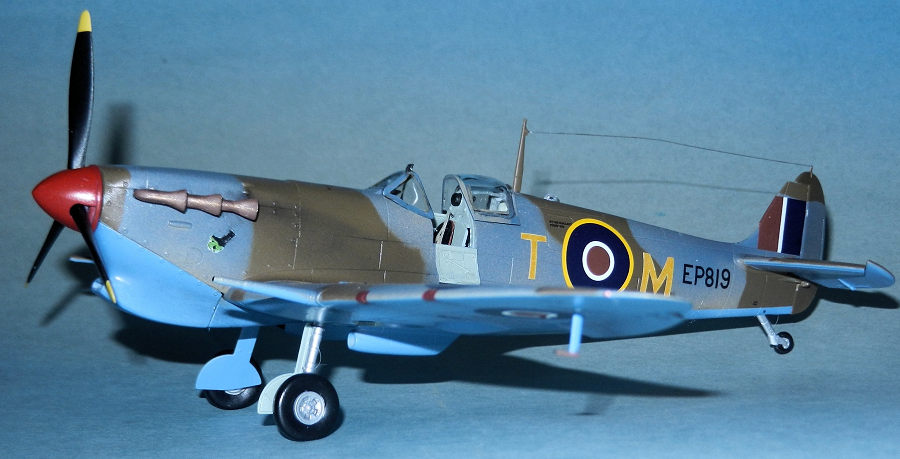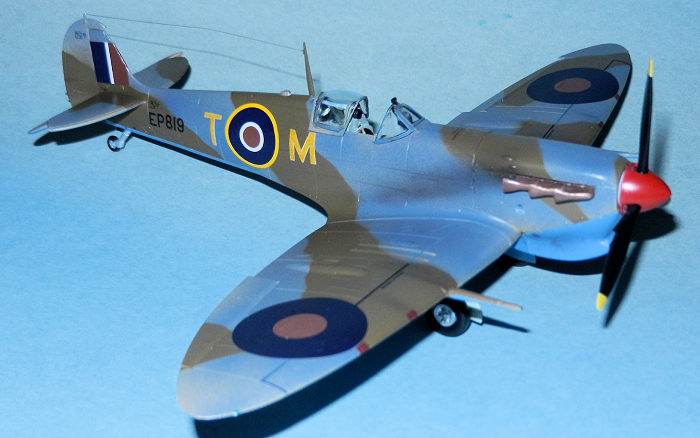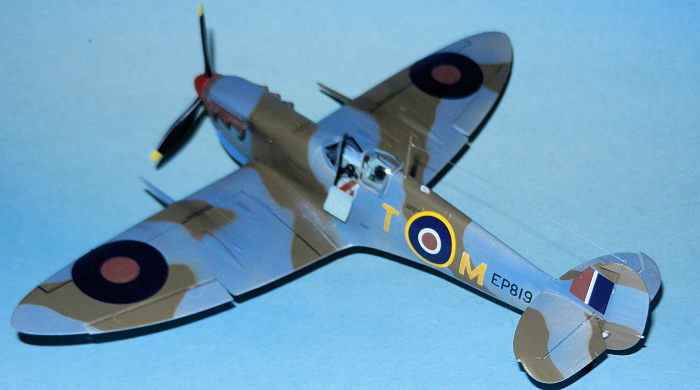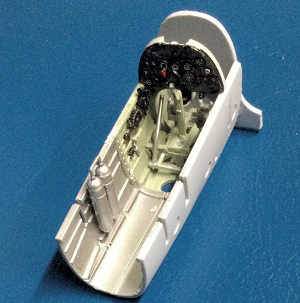
| KIT #: | A05125A |
| PRICE: | CAN$32.00 |
| DECALS: | Two options |
| REVIEWER: | Pablo Calcaterra |
| NOTES: | Airwaves photoetched seat harness. A tribute to a 100 year old Malta veteran living in London, ON |

| HISTORY |
Tom Hennesy was born in Dublin on May 31, 1922. His father had two brothers: one was living in Buenos Aires, Argentina and died fighting in World War I. The youngest stayed at home taking care of the family. Tom’s dad was gassed during the war but survived. His brother Bert joined the RAF but died in a flying accident (1938) in Palestine shortly before World War Two commenced. Tom joined the RAF in Belfast in early 1941 when he was eighteen and was sworn into the RAF in May. he was trained in the them before they were in the war. The new RAF trainees arrived in Halifax and headed east to train at Manning Depot in Toronto. After a few weeks the boarded a train and crossed the border arriving at Ponca City for their flight training. This was the very first course in Ponca and they were #6 BFTS. While they were there Pearl Harbor took place. The U.S. was at war. They were split into two flights (A and B) first flying Stearmans followed by the Vultee, a terrible plane to fly (heavy with no early indication of a stall) and they finished in Harvards. Now a Flight Sargeant, he returned to England again in a convoy through the dangerous North Atlantic in March 1942 ending up at 51 OTU in Wales. In July he was transferred to 504 Sqn. based in Balleyhalbert close to Belfast where Tom flew convoy protection.
In January 1943 he was
posted overseas. The destination was unknown but clearly based on shorts, pith
helmet and short sleeved shirts they were going to a warm place. Tom and his
colleagues landed in Gibraltar waiting for Squadron assignment. The Gibraltar
runway runs East to West and on the opposite side of the bay in Spain the
Germans had their own Embassy that would report their activities as Spain was
neutral. Eventually they departed for Malta in a Liberator that flew south
towards Africa and then along the coast and once south of Malta flew straight
north to the islands landing in Luqa. There was extensive damage to Valetta with
many ships sunk or damaged in the harbour. Tom was assigned to 249 (Gold Coast)
Sqn in Kendri on the south coast of Malta. Their work system was 24 hours on and
24 hours off. They started one hour before daybreak and stood down half an hour
before sunset. There was no acclimatization time. Even the new pilots were sent
up immediately into action. This was towards the end of their last blitz on
Malta. On one assignment they dove after a Ju88 but he was faster than the
Spitfires and was able to out distance himself in a power dive. Tom was assigned
a Spitfire that was coded T * M (* is the roundel). The name of the plane could
be then spelled like his: TOM. Not surprisingly he was nick named Paddy like all
Irishmen in service. An insignia was painted on the nose of his Spitfire Mk V.
It was an English boot crushing a Shamrock! This was because the
 English
pilots used to joke that he was a German Spy because he was coming from neutral
Republic of Ireland. Tom shared the plane with a pilot of Northern Ireland who
was in the other flight. Eventually poor T*M was pranged by the other pilot. One
of the ground crew took one of the propellers and on it he wrote a poem to T*M
which was placed as tombstone for his plane.
English
pilots used to joke that he was a German Spy because he was coming from neutral
Republic of Ireland. Tom shared the plane with a pilot of Northern Ireland who
was in the other flight. Eventually poor T*M was pranged by the other pilot. One
of the ground crew took one of the propellers and on it he wrote a poem to T*M
which was placed as tombstone for his plane.
Eventually 249 Sqn started fighter bomber missions over Sicily in November 1942 into 1943. One particular mission stands out in Tom’s memory: four planes flew to Palermo where the Americans had set their metal landing strip on the beach. They were very well fed and kept. They had an excellent breakfast and took off to attack a radar station in Capri close to Naples in Italy. It was a tough fly as they had to stay on the deck for some hours with the sky and water blended as one. Their leader excelled at navigation and kept them below radar detection, was excellent and did a perfect navigation. They strafed the station, dropped their bombs and returned to the American landing strip, refueled and flew back to Malta. They did not know why they had done this. They were always told what to do but no context or explanation. It turns out that their attack was meant to help protect the American B-24s flying to attack the oil fields in Ploesti (Romania).
249 Sqn moved to Italy in October 1943. Sweeps were carried out over Albania and Yugoslavia to support Tito’s partisans. They would receive a call and take off immediately to attack. The partisans were keeping a good eye on the enemy who moved always in motorized vehicles. The RAF pilots had the green light to attack any German car or truck. Partisans wither walked or rode mules. They blew up the bridge ahead of a German column and the one behind the column trapping the Germans and then destroying the convoy. Once when returning to Comisso from a mission in Yugoslavia and having relaxed a bit out of the sun a Me109 dove on Tom. He had not seen it. He only knew he was under attack because of the tracers flying by him. Tom pushed the stick forward with full power and canted successfully dodging the German who must have thought that he had shot him down. In fact, his plane did not receive a single hit.
A tour was 200 hours. When he was getting close to this milestone he hoped his last mission was going to be a safe mission like escorting a ship. It turned out to be a dive bombing mission! Tom was not happy. But they went ahead and did the operation where they bombed the target in the middle of a lot of flak. Landing after his last mission was the most beautiful experience he remembers from the war. He was “rested” in Ismailia, Egypt in 1944 where he trained new pilots, flew Hurricanes, towed drogues and helped with the bombing practice and training. On completion of the 200 operational hours he was made Flight Lieutenant and his officers uniform, heavy English wool, was crafted by a skilled Egyptian tailor. While doing the tasks mentioned above was when he almost lost his life...twice! On one occasion he was towing the drogue. The pilot who was going to attack it attacked Tom instead! The trainee was supposed to get a camera shot. Instead he pushed the live shot, his bullets damaging Tom’s plane. With hydraulics damaged Tom made an emergency landing back in base. The other time they were preparing the bombing range and had set up the sign to Red (a board painted red on one side which means Range Closed and green on the other meaning Range Open). Tom and his colleagues were walking in the range setting things up and out of the blue this chap dives on the Range and attacks it while the sign was red! They were attacked with guns, and they were lucky to get out unscathed. The rookie surely was punished when he returned to base.
 While
stationed in Ismailia VE took place. Tom thought that he was going to be
demobilized but to his surprise he was sent to India to get ready to fight the
Japanese. The pilots flew in a Sunderland all the way to India making several
stops along the way. At Hyderabad they trained to participate in the last stages
of the attack on Japan. Commandos had to capture the Singapore airport first.
Then they would take their Spitfires from an aircraft carrier and land them in
Singapore. It was thought that with the speed of the carrier plus the forward
speed of the Spits and the wind they would be able to take off safely. Those two
weeks of training were stressful, and the poor Spits took a lot of punishment.
Pilots would close tight on the brakes, give full power till the tail was almost
lifting, release the brakes and rush forward hoping to be on the air before the
line that marked “the end of the aircraft carrier”. They had to be doing 55 mph
which added to the 15 mph of the ship would give them the 70 mph which was the
minimum airspeed needed to keep the plane in the air before stalling. War ended
while they were still being trained. With their special training cancelled they
were put in charge of censoring letters! One day they were playing a game of
soccer when the goalie came forward to grab the ball and as he was striking it
his lower leg snapped, fractured both bones. Tom was shipped back to the UK on
crutches. When approaching Southampton in the middle of the night and having
seen the lights of the coastal towns of France and England on Tom realized that
everything was back to normal. He had survived having seen so many comrades die
and so much tragedy. Tom finally broke down and started to cry his first tears,
ever.
While
stationed in Ismailia VE took place. Tom thought that he was going to be
demobilized but to his surprise he was sent to India to get ready to fight the
Japanese. The pilots flew in a Sunderland all the way to India making several
stops along the way. At Hyderabad they trained to participate in the last stages
of the attack on Japan. Commandos had to capture the Singapore airport first.
Then they would take their Spitfires from an aircraft carrier and land them in
Singapore. It was thought that with the speed of the carrier plus the forward
speed of the Spits and the wind they would be able to take off safely. Those two
weeks of training were stressful, and the poor Spits took a lot of punishment.
Pilots would close tight on the brakes, give full power till the tail was almost
lifting, release the brakes and rush forward hoping to be on the air before the
line that marked “the end of the aircraft carrier”. They had to be doing 55 mph
which added to the 15 mph of the ship would give them the 70 mph which was the
minimum airspeed needed to keep the plane in the air before stalling. War ended
while they were still being trained. With their special training cancelled they
were put in charge of censoring letters! One day they were playing a game of
soccer when the goalie came forward to grab the ball and as he was striking it
his lower leg snapped, fractured both bones. Tom was shipped back to the UK on
crutches. When approaching Southampton in the middle of the night and having
seen the lights of the coastal towns of France and England on Tom realized that
everything was back to normal. He had survived having seen so many comrades die
and so much tragedy. Tom finally broke down and started to cry his first tears,
ever.
When the war ended he was 24 years old. Tom had no formal training except as a pilot. There were no jobs for fighter pilots. He was sent to Oxford to get trained as an executive. It was a three months long course. He did not like the jobs he was offered or worked on. Once in London (UK) he saw an ad promoting Ontario. He travelled to Canada to work as a farmer but the owner of the company did not hire him because he was Irish. Then he found a job taking care of pigs on a farm in London but did not like it at all and left after three weeks. Back in Toronto he was finally able to find a job...in a bank. While there he was staying with a family who had a son called Stuart. They asked him if he had ever thought about becoming a teacher because he was very good at teaching Stuart. Tom went to Auburn College and learned to be a teacher. During his first year teaching he taught grades seven and eight in “Cabbage Town”. Eventually he met Howard Carr a former submarine captain and he told him about becoming a physical education teacher. Tom did this for a while until he decided to change jobs and became an Insurance Salesman. Made lots of money but he hated it. Finally he went back to teaching but this time as a supervisor for 10 years in Sarnia. In 1959 he moved to a new job in London (Ontario) where he was supervising physical education for the original 14 schools. This number grew to 39 when others in the area were annexed. The rest of his life he worked as a physical education supervisor (or consultant they would call it now) until he retired in 1985
Early in 2022 Tom was reading an article in Legion Magazine. It spoke about the plight of homeless veterans in Canada. It concluded with the strong invitation to its readers: they have to do something. He immediately lifted his eyes from the magazine and said to his wife, Joyce: “I could do something! I could walk”. She encouraged him saying: ”Go for it!”. Tom contacted London’s 145 Vimy Branch of the Royal Canadian Legion. Quickly a team of four gathered to support his vision for a walk. Calling ourselves the Core Fore, they were Randy Warden, Bruce Stock, his wife Joyce and Tom. Together they organized the campaign, set up the fund. The original 100 km became 100 miles because he was feeling very well. Tom would walk approximately 4 km a day. By Canada Day, July 1, 2022 he exceeded his goal having collected more than CAD 56,000. He had completed 100 miles and more importantly raised awareness of the needs of their less fortunate men and women who had served their country.
Tom says that his life experiences have helped him to appreciate the smallest things in life. He is exceedingly thankful for the ongoing love and commitment of his family, and particularly his wife, Joyce. If he could summarize his life in one word it would be Gratitude. Tom is grateful for his health, his friends and family and for his wonderful adopted country, Canada, “one of the best democracies in the entire world”
| THE KIT |
This is the very nice Airfix Spitfire Vb issued just a couple of years ago (2020) and that started with the kit from 2014.
There are lots of extra parts that allow you to build a clipped, standard or pointed wing, bombs, different types of exhausts, propellers and spinners, multiple types of canopies and windshields…in short a plethora of parts that will end up in the spares box or that allow you to build something different from a Vb. Engraving is nice and the cockpit is very complete.
| CONSTRUCTION |
 There’s not
a lot to comment about it. I would only say that some of the parts need to be
cleaned up a bit or sanded down to make them fit in place (particularly in the
cockpit area). I added seat harnesses from Airwaves. Following the instructions
is very easy and steps are in a logical sequence. I really like how the new
Airfix instructions highlight in red the previously assembled parts.
There’s not
a lot to comment about it. I would only say that some of the parts need to be
cleaned up a bit or sanded down to make them fit in place (particularly in the
cockpit area). I added seat harnesses from Airwaves. Following the instructions
is very easy and steps are in a logical sequence. I really like how the new
Airfix instructions highlight in red the previously assembled parts.
 I had
to use a bit of putty in the fuselage to wings unions. Nothing major though. The
Vc propeller supplied by Airfix is a tiny bit too pointy and long so I sanded it
to give it a better shape. But it is totally usable as is. After washing the
plane and stuffing the cockpit with tissue paper I proceeded to paint it.
I had
to use a bit of putty in the fuselage to wings unions. Nothing major though. The
Vc propeller supplied by Airfix is a tiny bit too pointy and long so I sanded it
to give it a better shape. But it is totally usable as is. After washing the
plane and stuffing the cockpit with tissue paper I proceeded to paint it.
| COLORS & MARKINGS |
First I started with a coat of light grey Vallejo Primer. Then the undersides received a coat of Vallejo Azure Blue. The top was then painted with Vallejo Mid Stone and then Dark Brown (demarcation done with worms of blue tac). As the planes were very conspicuous when flying over the Mediterranean they received a coat of a blueish grey to cover the Mid Stone colour. Pictures of Tom’s plane show this. In this case I covered the Mid Stone areas with a light coat of ModelMaster Acryl 4744 Intermediate blue
My usual technique of sanding black pastel and applying it to some areas with a brush delivered some wear and depth (moveable surfaces). Stains behind the exhausts were created using a mix of rust and black-sanded pastels and a brush. These were also used to get the undersides a little bit dirty. Formation lights were painted in silver followed by a tiny drop of ModelMaster clear red and green (white for the rudder one).
 The propeller
hub was painted red and the blades black with yellow tips. The main landing gear
was glued in place (minus wheels and doors) as support for the plane during the
process of applying Future. After the layers of Future were applied the plane
was ready for the decals.
The propeller
hub was painted red and the blades black with yellow tips. The main landing gear
was glued in place (minus wheels and doors) as support for the plane during the
process of applying Future. After the layers of Future were applied the plane
was ready for the decals.
When it came to decals, the challenge was to get 2 x T and 2 x M in yellow. After searching for something accurate in my binder with decals I finally had to print my own in white decal paper.
The roundels came from the spares. Stencils are the kit’s. The only detail here was to overspray slightly the ones that would have sat on the Middle Stone colour using the blue mentioned above. I cut the long Do not walk lines and applied them on the dark brown. The remainder parts that sat under the blue were airbrushed lightly to achieve a see through effect. Once the paint was dry these were carefully applied ensuring that the paint did not touch the water used to release them from the backing paper.
Tom’s personal insignia (the British boot crushing a four leaves clover) was designed by me, approved by Tom and printed on white decal paper. The ink was protected with Decal solution. Carefully I cut around it using an Xacto knife and just in case I avoided getting the water touching the ink. A coat of Model Master Acryl semi gloss covered and protected the decals.
From this moment on everything went fine and fast: he glued the main and tail wheel, propeller, gunsight with pad painted in brown, pitot, exhausts (painted with Vallejo rust and dry brushed in bronze), the rear mirror, windshield, antenna post and finally using very thin wire I made the aerial.
| CONCLUSIONS |
A very nice kit. It is far superior to the old one from the 70s. I really like it. So much so that I actually built two at the same time: one for Tom (presented at the Christmas Luncheon at the Wing on December 16 2022) and one for me.
Who would have thought that I was ever going to be able to meet an actual WWII Spitfire veteran! Thank you Tom for everything you did…and to you and Joyce for your time and friendship.
| REFERENCES |
Interview to Flt Lt Hennessy and Joyce Hetherington
ORB 427 Sqn – 540 and 541 Forms
Pablo Calcaterra
25 May 2023
Copyright ModelingMadness.com. All rights reserved. No reproduction in part or in whole without express permission from the editor.
If you would like your product reviewed fairly and fairly quickly, please contact the editor or see other details in the Note to Contributors.